1993 PONTIAC BONNEVILLE maintenance
[x] Cancel search: maintenancePage 234 of 322
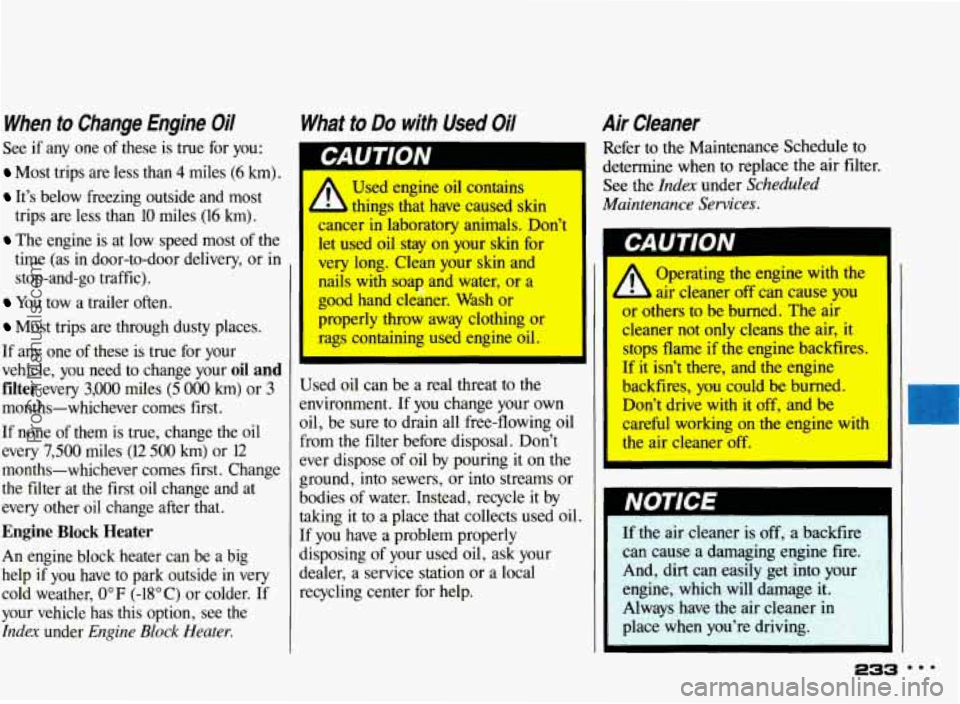
When to Change Engine Oil
See if any one of these is true for you:
Most trips are less than 4 miles (6 km).
It’s below freezing outside and most
trips are less than
10 miles (16 km).
The engine is at low speed most of the
time (as
in door-to-door delivery, or in
stop-and-go traffic).
You tow a trailer often.
Most trips are through dusty places.
If any one of these is true for your
vehicle, you need to change your oil
and
filter every 3,000 miles (5 000 km) or 3
months-whichever comes first.
If none of them is true, change the oil
every
7,500 miles (12 500 km) or 12
months-whichever comes first. Change
the filter at the first oil change and at
every other oil change after that.
Engine Block Heater
An engine block heater can be a big
help if you have to park outside
in very
cold weather,
0°F (-18OC) or colder. If
your vehicle has this option, see the
Index under Engine Block Heater.
What to Do with Used Oil Air Cleaner
things that have caused skin
1 cancer in laboratory animals. Don’t
let used
oil stay on your skin fbr
very long. Clean your skin and
nails with soaQ and water, or a
good hand cleaner. Wash or
properly throw away clothing or
rags containing used engine oil. Refer
to the Maintenance Schedule to
determine when to replace the air filter.
See the
Index under Scheduled
Maintenance Services.
Used oil can be a real threat to the I
environment. If you change your own
oil, be sure
to drain all free-flowing oil
from the filter before disposal. Don’t
ever dispose of oil by pouring it on the
ground,
into sewers, or into streams or
bodies
of water. Instead, recycle it by
taking it to a place that collects used oil.
If you have a problem properly
disposing
of your used oil, ask your
dealer, a service station or a local
recycling center for help.
1%
CAUTION
Operating the engine with the
air cleaner
off can cause you
uz others to be burned. The air
cleaner not
only cleans the air, it
stops flame if the engine backfires.
If it isn’t there, and the engine
backfires, you could be burned.
I Don’t drive with it off, and be
I careful working on the engine with
I the air cleaner off. I
If the air cleaner is off, a backfire
can cause a damaging engine fire.
And, dirt can easily get into your
engine, which will damage it.
Always have
the air cleaner in
place when you’re driving.
...
ProCarManuals.com
Page 237 of 322
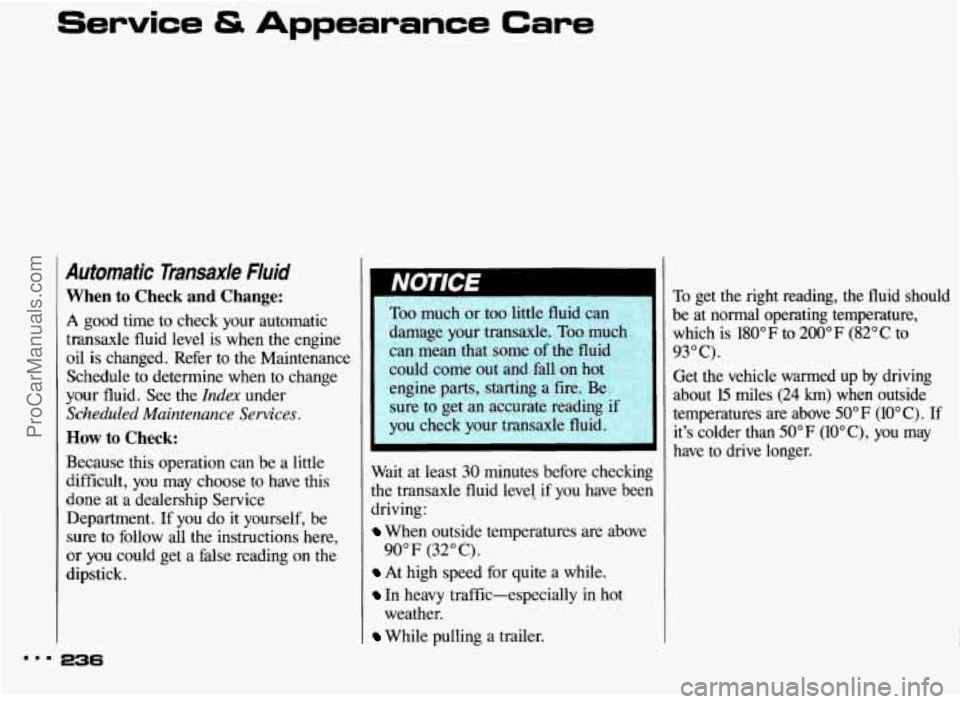
Service & Appearance Care
Automatic Transax/e Fluid
When to Check and Change:
A good time to check your automatic
transaxle fluid level is when the engine
oil is changed. Refer to the Maintenance
Schedule to determine when to change
your fluid. See the
Index under
Scheduled Maintenance Services.
How to Check:
Because this operation can be a little
difficult, you may choose to have this
done at a dealership Service
Department. If
you do it yourself, be
sure to follow all the instructions here,
or you could get a false reading on the
dipstick.
Too much or too little fluid can
damage your transaxle.
Too much
can mean that some of the fluid
could come
out and fall on hot
engine parts, starting
a fire. Be
sure to get an accurate reading if
you check your transaxle fluid.
Wait at least
30 minutes before checking
the transaxle fluid level if
you have been
driving:
When outside temperatures are above
At high speed for quite a while.
In heavy traffic-especially in hot
While pulling a trailer.
90" F (32" C).
weather.
To get the right reading, the fluid should
be at normal operating temperature,
which is
180°F to 200°F (82°C to
93" C).
Get the vehicle warmed up by driving
about
15 miles (24 km) when outside
temperatures are above
50" F (10" C). If
it's colder than
50°F (lO°C), you may
have
to drive longer.
ProCarManuals.com
Page 239 of 322

Service & Appearance Care
Automatic Transaxle Fluid (CONTJ
How to Add Fluid:
Refer to the Maintenance Schedule to
determine what kind
of transaxle fluid to
use. See the
Index under Fluids &
Lubricants.
If the fluid level is low, add only enough
of the proper fluid to bring
the level up
into the cross-hatched area on the
dipstick. It doesn't take much fluid,
generally less than a pint
(0.5 L). Don't
overfill. We recommend that you use
only fluid labeled DEXRON@-IIE,
because fluids with that label are made
especially for your automatic transaxle.
Damage caused by fluid other than
DEXRON@-IIE is not covered by your
new vehicle warranty. After adding
fluid, recheck the fluid
level as described under
How to Check.
When the correct fluid level is obtained,
push the dipstick back
in all the way.
Engine Coolant
The following explains your cooling
system and how to add coolant when
it
is low. If you have a problem with
engine overheating, see the Index under
Engine Overheating.
The proper coolant for your Pontiac
will:
Give freezing protection down to
Give boiling protection up to 262°F
Protect against rust and corrosion.
-34°F (-37°C).
(128" C).
Help keep the proper engine
temperature.
a
Let the warning lights work as they
should.
I.. 238
ProCarManuals.com
Page 243 of 322
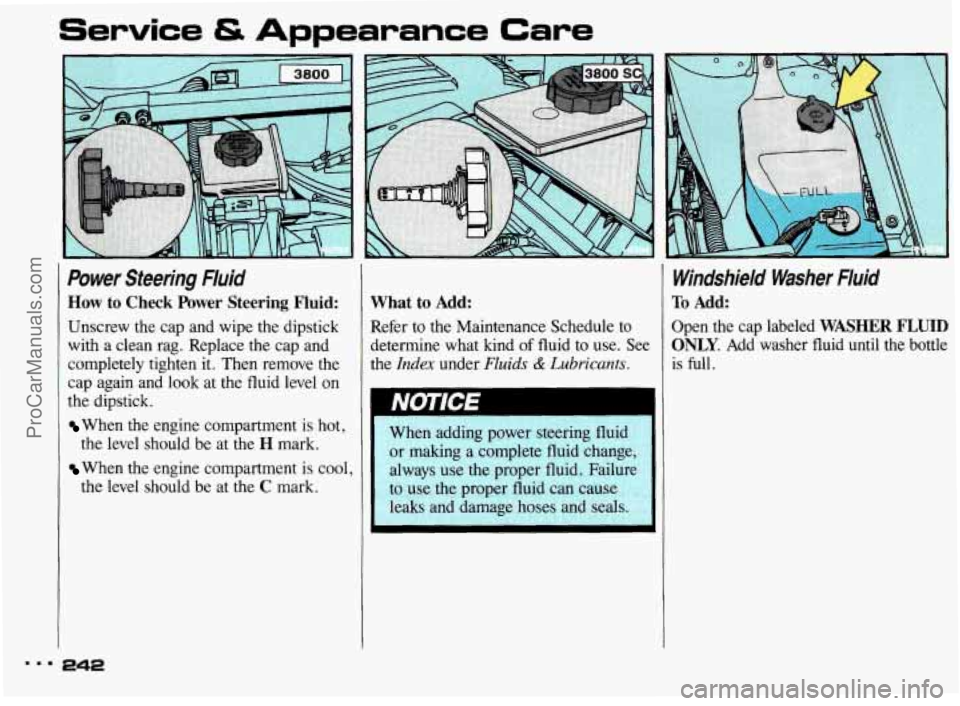
Service & Appearance Care
Power Steering Fluid
How to Check Power Steering Fluid:
Unscrew the cap and wipe the dipstick
with a clean rag. Replace
the cap and
completely tighten it. Then remove the
cap again and look
at the fluid level on
the dipstick.
When the engine Compartment is hot,
When the engine compartment is cool,
the
level should be at
the H mark.
the level should be at the
C mark.
I.. 242
I
What to Add:
Refer to the Maintenance Schedule to
determine what lund
of fluid to use. See
the
Index under Fluids & Lubricants.
1
When adding power steering fluid
or making a complete fluid change,
always use the proper fluid. Failure
to use the proper fluid can cause
leaks and damage hoses and seals.
Windshield Washer Fluid
To Add:
Open the cap labeled WASHER FLUID
ONLY. Add washer fluid until the bottle
is
full.
ProCarManuals.com
Page 252 of 322
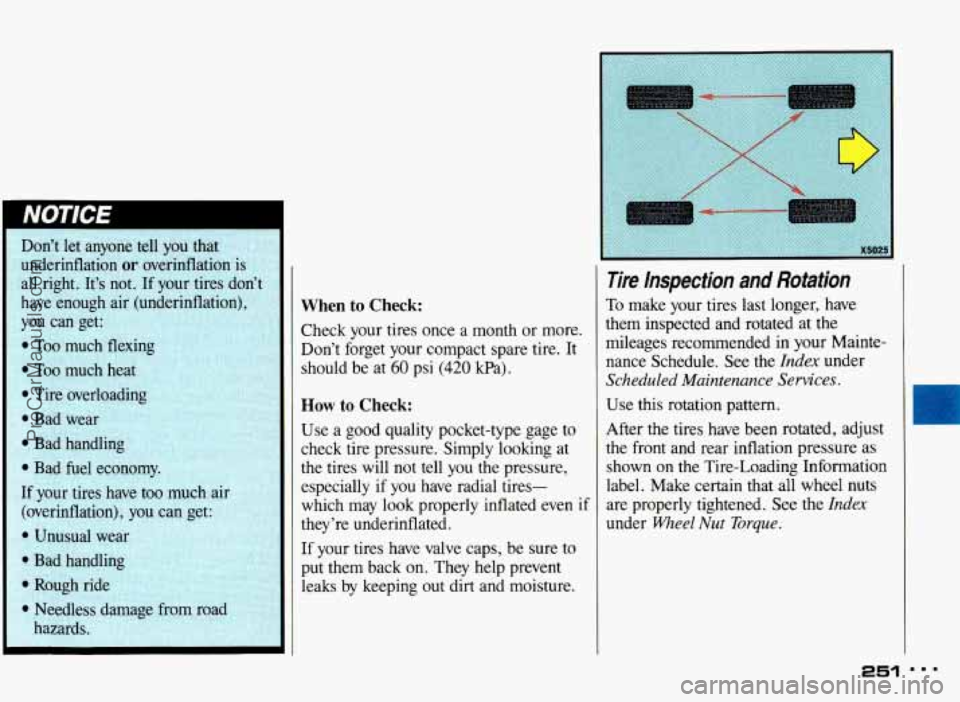
Don't let anyone tell you that , 1 ,~ ,%$:
underinflation or overinflation
all right. It's not.
If your tires don't ;1
When to Check:
Check your tires once a month or more.
Don't forget your compact spare tire. It
should be at
60 psi (420 kpa).
How to Check:
Use a good quality pocket-type gage to
check tire pressure. Simply looking at
the tires will not tell you the pressure,
especially if
you have radial tires-
which may look properly inflated even if
they're underinflated.
If your tires have valve caps, be sure to
put them back on. They help prevent
leaks by keeping out dirt and moisture.
Tire lnspection and Rotation
To make your tires last longer, have
them inspected and rotated at the
mileages recommended in your Mainte-
nance Schedule. See the
Index under
Scheduled Maintenance Services.
Use this rotation pattern.
After the tires have been rotated, adjust
the front and rear inflation pressure as
shown on the Tire-Loading Information
label. Make certain that all wheel nuts
are properly tightened. See the
Index
under Wheel Nut Torque.
ProCarManuals.com
Page 265 of 322

Undenbody Maintenance
Chemicals used for ice and snow
removal and dust control can collect on
the underbody. If these are not removed,
accelerated corrosion (rust) can occur
on the underbody parts such as fuel
lines, frame, floor pan, and exhaust
system even though they have corrosion
protection.
At least every spring, flush these
materials from the underbody with plain
water. Clean any areas where mud and
other debris can collect. Dirt packed in
closed areas of the frame should be
loosened before being flushed. Your
dealer or an underbody vehicle washing
system can do this for you.
Chemical Paint Spotting
Some weather and atmospheric
conditions can create a chemical fallout.
Airborne pollutants can
fall upon and
attack painted surfaces on your vehicle.
This damage can take two
forms:
blotchy, ringlet-shaped discolorations,
and small irregular dark spots etched
into the paint surhce.
Although no defect in the paint
job
causes this, Pontiac will repair, at no
charge
to the owner, the surfaces of new
vehicles damaged by this fdlout
condition within
12 months or l2,OOO
miles (20 0oO km) of purchase,
whichever comes first.
WIN) Vehicle Identification Number
This is the legal identifier for your
Pontiac. It appears on
a plate
in the front
corner
of the instrument panel, on the
driver’s side. You can see it if you look
through the windshield from outside
your vehicle. The VIN
also appears on
the Vehicle Certification and Service
Parts labels and the certificates of title
and registration.
m.. 264
ProCarManuals.com
Page 272 of 322
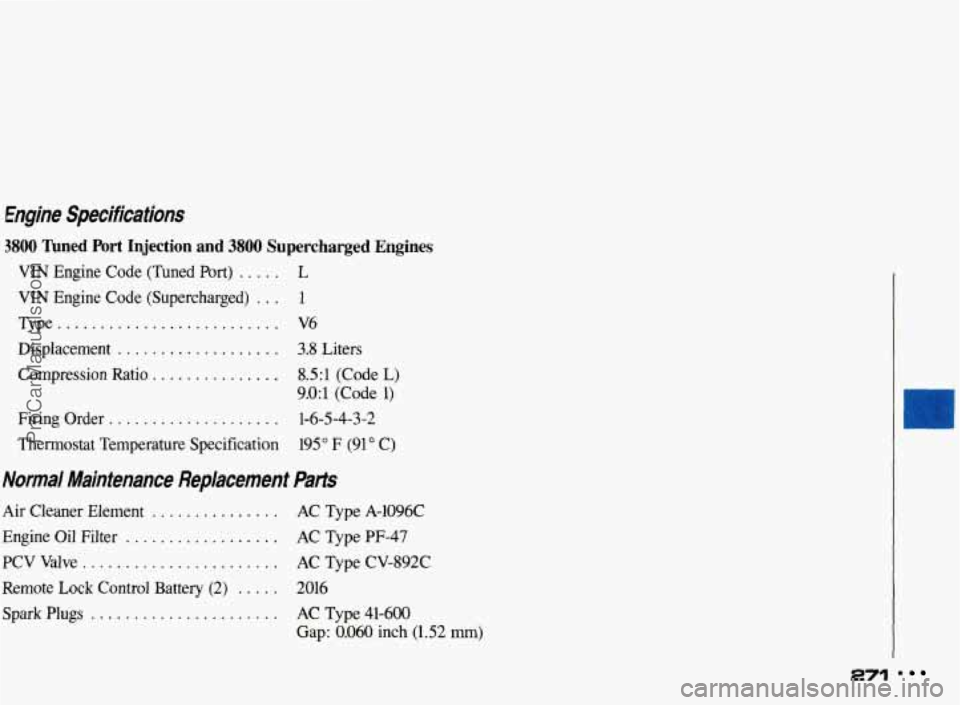
Engine Specifications
3800 fined Port Injection and 3800 Supercharged Engines
VIN Engine Code (Tuned Port) ..... L
VIN Engine Code (Supercharged) ... 1
Type .......................... V6
Displacement
................... 3.8 Liters
Compression Ratio
............... 8S:l (Code L)
9.0:l (Code 1)
Firing Order .................... 1-6-5-4-3-2
Thermostat Temperature Specification 195"
F (91 O C)
Normal Maintenance Replacement PaHs
Air Cleaner Element ............... AC Type A-1096C
Engine Oil Filter
.................. AC Type PF-47
PCV
Valve ....................... AC Type CV-892C
Remote
Lock Control Battery (2) ..... 2016
Spark Plugs ...................... AC Type 41-600
Gap: 0.060 inch (1.52
mm)
n
271
ProCarManuals.com
Page 276 of 322

KEEP ENGINE OIL
AT THE PROPER
LEVEL AND CHANGE AS
RECOMMENDED
This part covers the maintenance
required
for your Pontiac . Your
vehicle needs these services to
retain its safety. dependability and
emission control performance
.
Have you purchased the
GM Protection Plan?
The Plan supplements your
new vehicle warranties
.
See your Pontiac dealer for details .
Part 7
Section
Introduction
A Word About Maintenance .......................... 276
Your Vehicle and the Environment
.......................... 276
How This Part is Organized ............................... 277
Using Your Maintenance Schedules
....................... 278
Selecting the Right Schedule
.............................. 278
A . Scheduled Maintenance Services
Schedule1 ............................................ 280
Schedule11
........................................... 282
Explanation
of Scheduled Maintenance Services .............. 284
AtEachFuelFill
....................................... 287
B . Owner Checks & Services
At Least Once a Month .................................. 287
At Least Once a Year
.................................... 288
C . Periodic Maintenance Inspections ........................... 290
D . Recommended Fluids & Lubricants ......................... 291
E . MaintenanceRecord ...................................... 294
875
ProCarManuals.com